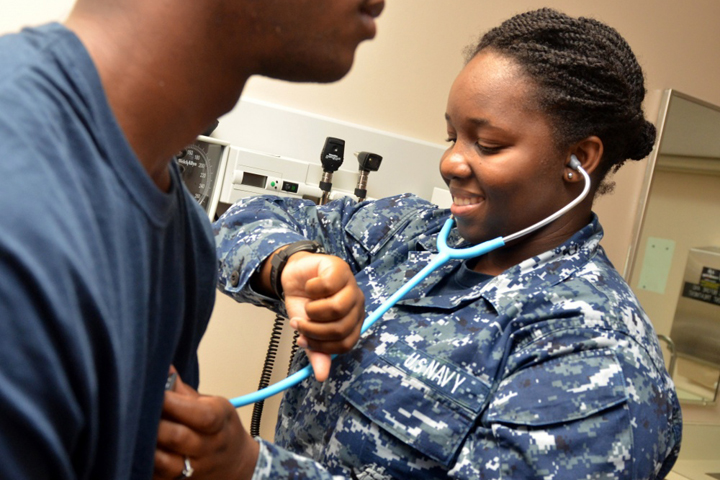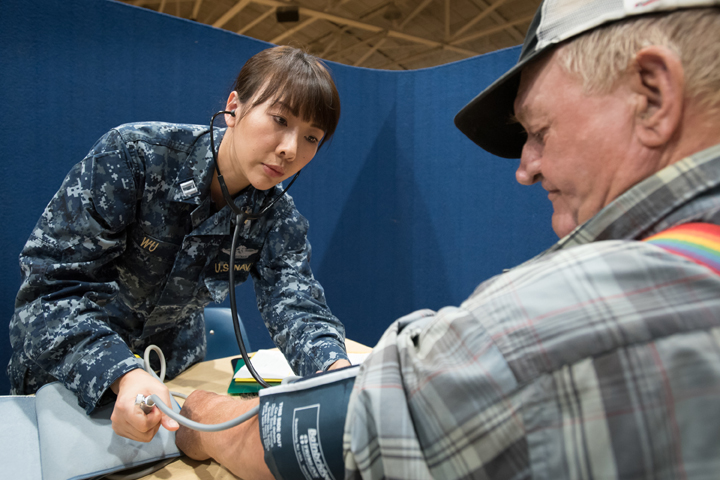
MHS raises awareness of heart health on National Wear Red Day

National Wear Red Day helps raise awareness of heart disease, heart attacks, and strokes. Join us for National Wear Red Day, Friday, Feb. 7. Wear red, snap a photo with your family and friends, and share it on social media using the hashtag #WearRedDay. (MHS photo)
What’s a great way to raise awareness of heart disease across the Department of Defense community? Join us for National Wear Red Day, Friday, Feb. 7. Wear red, snap a photo with your family and friends, and share it on social media using the hashtag #WearRedDay.
According to the Centers for Disease Control and Prevention, heart disease is the leading cause of death in the United States. Heart disease and stroke cause more than 20 percent of deaths among women each year. A woman dies of cardiovascular disease approximately every 80 seconds. But there is hope – diseases of the heart can be prevented.
The CDC recommends four basic steps for reducing your risk of cardiovascular disease, which could cause heart attack, stroke, or other illness.
- Eat healthy – Think about what you eat. Make smart choices, with fresh fruits and vegetables, whole grains, low-fat dairy products, skinless poultry and fish, and nuts and legumes. Also, limit saturated fats, sodium, red meat, and sugar-sweetened beverages.
- Manage blood pressure – Nearly half of American adults have high blood pressure.While hereditary factors contribute to your risk of hypertension, a healthy lifestyle also contributes to increased risk of heart attack, stroke, or other illnesses.
- Move more – For adults, the U.S. Surgeon General recommends two-and-a-half hours of moderate-intensity exercise each week; children should get about an hour per day.
- Don’t smoke – Smoking greatly increases your risk of cardiovascular disease. If you do smoke, you can lower your risk by reducing smoking or quitting.
According to the CDC, heart attack symptoms differ between men and women but all warning signs should be treated as if your life depends on it.
Possible Heart Attack Symptoms
If you have any of these signs of a heart attack, call 911 and get to a hospital right away:
- Uncomfortable pressure, squeezing, fullness or pain in the center of your chest. It lasts more than a few minutes or goes away and comes back.
- Pain or discomfort in one or both arms, the back, neck, jaw or stomach.
- Shortness of breath with or without chest discomfort.
- Other signs such as breaking out in a cold sweat, nausea or lightheadedness.
The most common heart attack symptom in women, as with men, is chest pain or discomfort. But women are somewhat more likely than men to experience some of the other common symptoms, particularly shortness of breath, nausea or vomiting, and back or jaw pain.
Possible Stroke Symptoms
If you have any of these stroke symptoms, call 911 and get to a hospital right away.
- Sudden numbness or weakness of the face, arm or leg, especially on one side of the body.
- Sudden confusion, trouble speaking or understanding.
- Sudden trouble seeing or blurred vision in one or both eyes.
- Sudden trouble walking, dizziness, loss of balance or coordination.
- Sudden severe headache with no known cause.
Throughout February, Health.mil will feature articles that can help you achieve Total Force Fitness and decrease your risk of cardiovascular disease.
Is exercise that’s too intensive resulting in your angina?
Article
4/8/2019

Angina is experienced as a feeling of tightness or pressure in the chest that can also radiate out to your neck, jaw, back or shoulders
Sudden cardiac death in young athletes
Article
3/7/2019

Sudden cardiac events can occur in seemingly healthy young people in their teens or twenties, including young servicemembers
Too much pressure: Hypertension a leading cause of heart disease
Article
3/5/2019

Healthy lifestyle now can help prevent disorder later
Focus on heart-healthy diet is perfect fit for February
Article
2/22/2019

With the typical American diet and lifestyle, many people put themselves at risk for developing various heart diseases
Taking care of your heart with TRICARE benefits
Article
2/19/2019

Getting preventive screenings now could save your life tomorrow
Deep vein thrombosis: What you need to know
Article
4/9/2018

Everyone’s potentially at risk, vascular surgeon says
Small changes, big results: Healthy lifestyle choices can make a difference for heart health
Article
4/6/2018

Risk for heart disease, the number one killer of Americans every year, can be decreased through healthy lifestyle and nutrition choices
Parents and doctors watch over a tiny heart
Article
3/19/2018

A military family’s rocky medical road with congenital heart disease
Focus on prevention … not the cure for heart disease
Article
2/21/2018

Many heart health problems can be avoided
Lose to win: Some service members struggle with weight
Article
2/7/2018

With numbers rising, programs help keep you shipshape
Absolute and Relative Morbidity Burdens Attributable to Various Illnesses and Injuries, Active Component, U.S. Armed Forces, 2016
Infographic
6/19/2017

This infographic documents healthcare burdens attributable to cardiovascular diseases among active component, U.S. Armed Forces in 2016.
Heart Disease and Its Effects on Service Members
Infographic
6/8/2016

Cardiovascular disease comprises disorders of the heart and circulatory system including coronary heart disease and cerebrovascular disease. This infographic provides data on the risk factors for cardiovascular disease among military members base on diagnostic codes in the electronic health records of service members during a 10-year surveillance period.
The ABC's of Heart Health
Infographic
2/22/2016

Bring awareness to the risks of heart disease and ways to stay heart healthy.
Take Charge of Your Heart Health
Infographic
2/16/2016

Take Charge of Your Heart Health with Regular Checkups
Keep Your Heart Healthy This Valentine's Day
Infographic
2/11/2016

4 ways to keep your heart healthy this Valentine's Day






















.png)











No hay comentarios:
Publicar un comentario